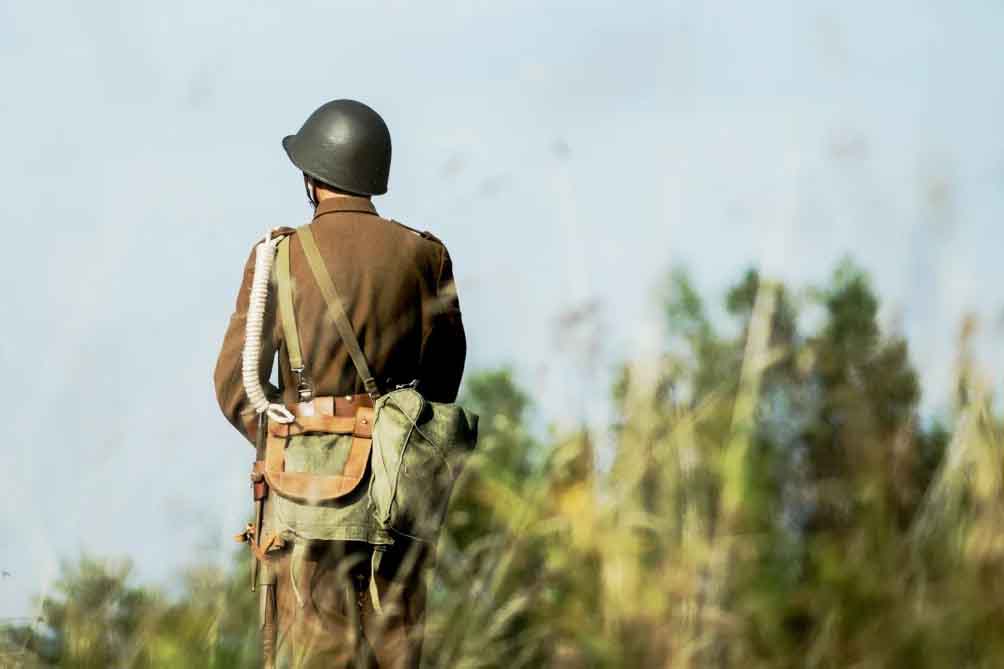In recent years, the places better reserved for historians have been taken by propagandists for whom the facts are irrelevant. Thanks to this approach, victims of the Second World War are equated with the perpetrators, and the actual perpetrators of war crimes are either silent, or semantically neutral terms are used for them in order to divert attention from their guilt.
When telling about the Second World War, there are no more Germans, there are some undefined Nazis, there are no German extermination camps, but there are Polish concentration camps. The German Chancellor speaks of Victory Day on May 8 as the day of Germany's liberation from Nazi occupation, and not of Germany's defeat in the war caused by the German Third Reich, for which Germany should repent and apologize until the end of time.
For many years, Russia has also presented its attack on Poland on September 17, 1939, as a desire to distance its border from Germany and help the Slavic population in the occupied territories. In this new narrative, the Russians remain silent about the fact that the attack on Poland was the implementation of the secret protocol of the Hitler-Stalin pact signed by Ribbentrop and Molotov. The Russians also do not write about the fact that, hand in hand with the Germans, they occupied most of the then Polish State, that they captured half of the Polish army with its weapons and equipment, which ultimately prevented the Polish from defending against the Germans, and that they murdered 21,000 captured officers of the Polish Army in Katyn, on the orders of Stalin, taking revenge for the defeat of the Red Army in the war with Poland in 1920.
The truth based on historical facts will defend itself, but for that to happen sooner rather than later, it is worth recalling the historical facts. So let's move on to the facts.
Austria
After the Second World War, the Austrians turned out to be true world champions in propaganda. Nobody today associates the good old Austrian Emperor Franz Joseph with Hitler. However, the Anschluss (annexation) of Austria to Germany in 1938 is remembered, which subconsciously places the Austrians among the victims of the Germans, and not among the accomplices of the German crimes. Meanwhile, on the basis of historical facts, one should not talk about German war crimes, but about German and Austrian war crimes.
Austria, which in 1939 had a population of 6,653,000, then had an army of over one hundred thousand, which was incorporated into the German army with its people and equipment. In the later years of World War II, the Austrians formed 22 divisions and 12 reserve regiments.
The most famous Austrian is of course Adolf Hitler. But an Austrian was also Adolf Eichmann, the chief coordinator and executor of the plan to murder European Jews, innocently dubbed the plan for the final solution of the Jewish question. In general, most of the members of Eichmann's staff responsible for the operation of murdering Jews in Europe were Austrian.
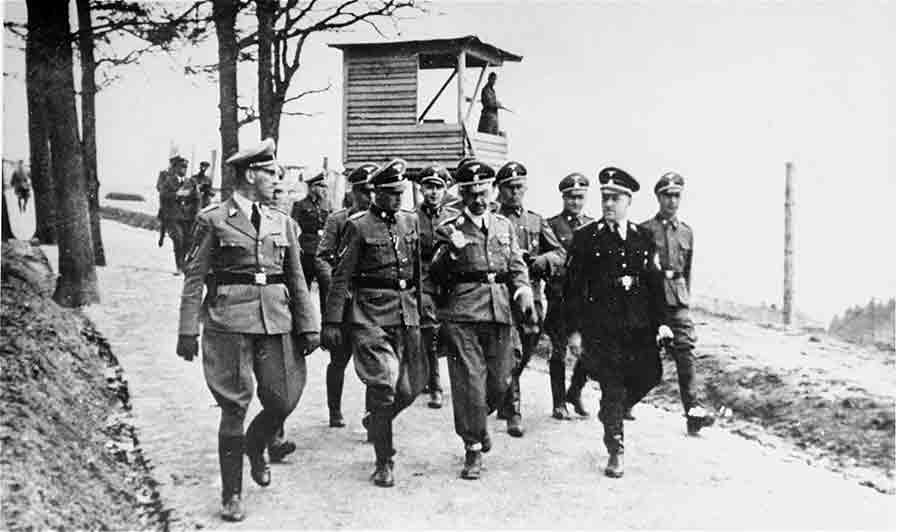
Ernst Kaltenbrunner (far left), Heinrich Himmler talks to camp commander, Franz Ziereis, during an official visit to Mauthausen concentration camp in 1941 (Source: Wikipedia)
Of Austrian nationality were, among others, Ernst Kaltenbrunner, head of the Reich Main Security Office (RSHA), Amon Goth, the commander of the camp in Kraków-Płaszów, known from the film Schindler's List. Of Austrian nationality was the executioner of Warsaw, Franz Kutscher, liquidated by the Polish underground, as well as Otto Skorzeny, Hitler's commando for special tasks.
Of Austrian nationality were the commanders of the German concentration camps: Mauthausen-Gusen, Dachau, Treblinka, and Sobibór. Austrian were also female overseers in concentration camps, female beasts like Hermine Braunsteiner and Maria Mandel. The Reich Commissar in the Netherlands was the war criminal Arthur Seyss-Inquart, the last Austrian Chancellor to sign Austria's anschluss to Germany. It is estimated that about 40% of the male and female supervisors in German Nazi concentration camps were Austrians.
The Netherlands
In 1940, the Netherlands had 8,890,000 inhabitants. It is true that after the attack of Germany on May 10, 1940, the royal family left for England, but the central state administration functioned smoothly, as before the war.
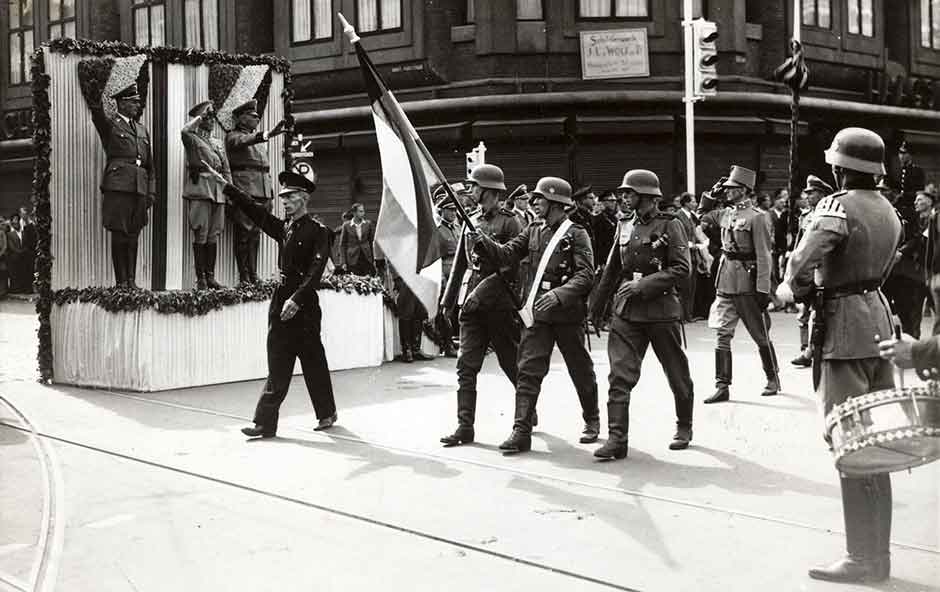
A detachment from the Volunteer Legion parades at The Hague in 1941 (Source: Wikipedia)
During World War II, the Dutch, mostly Flemish, who were descendants of Germanic tribes, were treated by the Germans as Aryans. The Dutch administration deported 107,000 Dutch Jews to the extermination camps. Thanks to the aid provided, only 16,100 Jews survived the occupation in the Netherlands. Worldwide Dutch concerns such as PHILIPS and UNILEVER cooperated with the German occupier, and 800,000 Dutch joined the Dutch Union party, which cooperated with Germany. 50,000 volunteers in the Waffen-SS units came from the Netherlands.
Belgium
Belgium had a population of 8,375,000 in 1938 (without the colonies). After the capitulation on May 28, 1940, the king remained in Belgium, while the royal family and the highest authorities emigrated to England. During the Second World War, the Belgian administration functioned as it did before the war.

Recruiting poster for the Flemish Legion, playing on the idea of a "European" war against the Soviet Union (Source: Wikipedia)
The German-Flemish Labor Union (De Vlag), founded in 1936, and the Flemish National Union, which from 1935 promoted the idea of Greater Belgium, collaborated with Germany. Between 1942 and 1944, 25,000 Jews and Roma were deported from Belgium to extermination camps. 40,000 volunteers in the Waffen-SS units came from Belgium. Waffen-SS General Felix Steiner reports 15,000 Walloons and 25,000 Flemish.
France
In 1938, France had 41,950,000 inhabitants (without the colonies). France signed an armistice with Germany on June 22, 1940 in the Compiègne forest, under which part of the country was directly occupied by Germany, who left the local French authorities in the occupied zone. Alsace and Lorraine were directly incorporated into the Reich, while the rest of the country was not occupied.
The administration and government of the truncated French State moved to the city of Vichy, and the Prime Minister and head of the French State was the hero of the First World War, Marshal Philippe Pétain.
France gave Germany the equipment and supplies of a land army, but its enormous fleet was not taken over by Germany, but only obliged to disarm. France could maintain an army of 100,000 on the European continent without tanks, anti-tank weapons, anti-aircraft guns and guns above the 75 mm caliber, and an army of 200,000 in colonies, without restrictions on weapons such as those in force in Europe.

Map of Vichy France, with unoccupied (blue) and occupied (red) France. This division was in force until 1942. (Source: Wikipedia)
Following the surrender of France in 1940, the British were seriously concerned about the possibility of the German Kriegsmarine taking over the entire mighty fleet of France. So they issued an ultimatum to the French: either join the further fight against Germany, or transfer the French fleet to the colony in the Caribbean (Martinique) and disarm it there, or put it under the protection of the United States.
The French admiral in command of the fleet rejected the ultimatum while assuring that he would not return the fleet to either Germany or Italy. Consequently, the British implemented the Catapult (Catapult) plan, under which on July 3, 1940 they seized French ships in British ports (a total of 243 units), and the British fleet based in Gibraltar opened fire on French ships based in the Algerian port of Mers-el-Kébir, sinking or damaging several French ships, including the battleship Bretagne, with which 977 French sailors went down. In total, 1,297 French sailors were killed and 350 injured by the British fire at Mers-el-Kébir.
In the following days, the British fleet sank, damaged or took over a dozen other French ships, including damaging the largest French battleship Richelieu, based in Dakar. Due to damage, this battleship then acted as a floating battery, shelling the British during the unsuccessful attempt to capture Dakar on September 21-25, 1940 (Operation Menace).
The French Vichy army and the British-Australian-French army of Free France (General de Gaulle) stood in front of each other. The French Vichy army was victorious, and in retaliation for the attack on Dakar, they bombed British Gibraltar, sinking an English patrol ship.
The Battle of Dakar weakened the position of General de Gaulle, who, as it turned out, did not have much following among his countrymen and did not manage to win over the French colonial forces of Vichy to the Free France side. On the other hand, Germany has obtained confirmation that Vichy, France, who is fighting the British, is a more valuable ally for them than General Franco's Spain.
French Vichy troops also fought with US-British troops during the landing operation in North Africa on November 8-16, 1942 (Operation Torch). Allied losses amounted to over 479 killed and 720 wounded. The losses of the French Vichy troops totaled over 1,346 killed and 1,997 wounded.
During World War II, the French zealously collaborated with the Germans in the deportation of Jews, both in the territories occupied by Germany, and in the territory of the French state of Vichy. The French police and gendarmerie carried out on their own, first the census of Jewish origin, which was then passed on to the Gestapo, and then carried out several mass arrests of Jews and deportations to concentration camps. French President Jacques Chirac publicly apologized in 1995 for the deportation by France of 75,000 French Jews to German extermination camps.
20,000 volunteers in the Waffen-SS units came from France. France also included 140,000 recruits from the Alsace and Lorraine area, 150,000 TODT employees, 25,000 Krieggsmarine employees in Brittany ports and the Bay of Biscay, 45,000 volunteers in other armed and paramilitary formations of the Third Reich.
Italy
Italy was Hitler's first, most important and greatest ally during World War II. In 1938, Italy had a population of 43,680,000. As the first fascist state in Europe, it can even be said that Italy was an inspiration for the Third Reich, because Hitler adapted and perfected the Italian version of fascism in Germany.
When Italy declared war between France and Great Britain (June 10, 1940), the Italian army numbered 1,687,950 soldiers. At the beginning of September 1943, the Italian army numbered 4,100,000 soldiers.
After the occupation of Sicily, on September 3, 1943, the Allies concluded a secret truce with Italy. Until then, the Italian state fought on the side of Germany. From 1943, "only" 650 thousand Italian volunteers fought on the side of Germany.
15,000 volunteers in the Waffen-SS units came from Italy. The largest Italian SS formations were:
- Waffen-ss Grenadier Brigade [1. Italian Brigade] (Waffen-Grenadier Brigade der SS Sturmbrigade)
- 29th Waffen-SS Grenadier Division (29. Waffen-Grenadier Division der SS).
Denmark
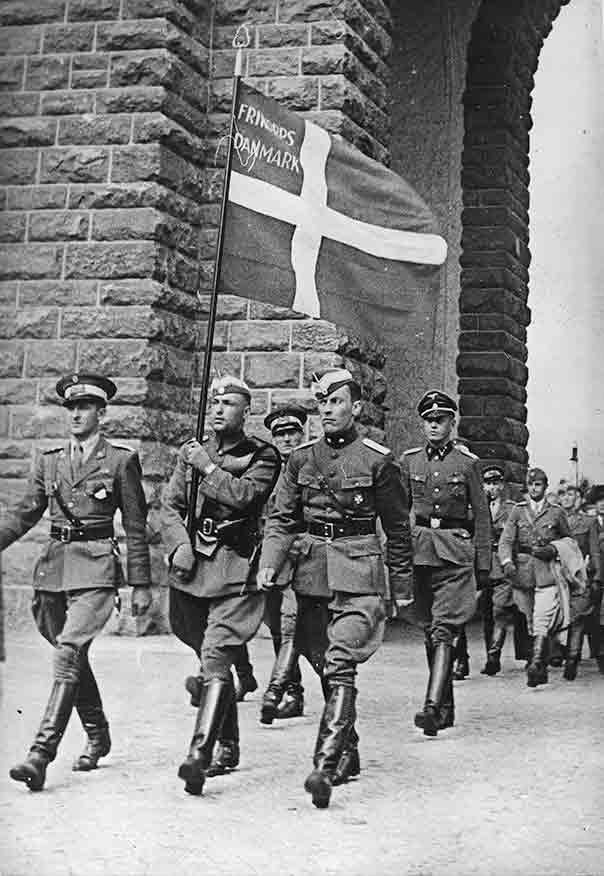
Members of Free Corps Denmark marching in Germany, 1941 (Source: Wikipedia)
Denmark had a population of 3,764,000 in 1938. 10,000 volunteers in the Waffen-SS units came from Denmark. The largest Danish SS formations were:
- 5th SS Panzer Division Viking (5. SS Panzer Division Wiking)
- 11th SS Panzer Grenadier Division Nordland (11. SS Panzergrenadier Division Nordland).
Norway
Norway had a population of 2,917,000 in 1938. 6,000 volunteers in the Waffen-SS units came from Norway. The largest Danish SS formation is:
- 5th SS Panzer Division Viking; Norwegian Legion (5. SS Panzer Division Wiking; Den Norske Legion).
One of the commanders of the Waffen-SS, General Felix Steiner, writes in his book, among other things: "The Norwegian fights near Leningrad are the history of individual operations of shock troops and patrols, during which the fighting spirit of the volunteers was most clearly evident," as well as, "out of 6,000 Norwegians who fought within these units, five hundred soldiers took part in the final phase of the defense of Berlin ”.
United Kingdom
As a chronicler, one should also note the participation of the subjects of the British Crown in the volunteer formations of the SS.
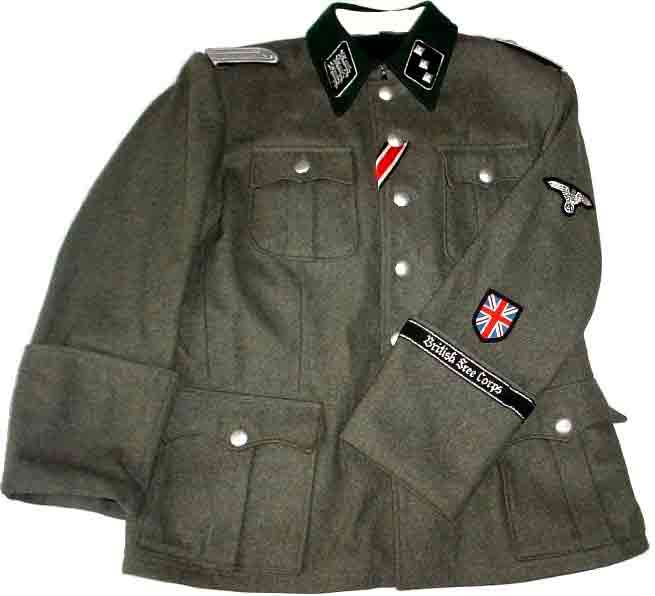
British Free Corps uniform (Source: Wikipedia)
The British SS Volunteer Corps (Britisches Freikorps) was founded in 1943 as the Saint George Legion. In January 1944, the Legion was renamed the Britisches Freikorps. It numbered about 60 soldiers. It was mainly of propaganda importance, but some soldiers took part in the defense of Berlin until the very end.
The British Queen's subjects also included the Indian SS Volunteer Legion (Indische Freiwilligen Legion der Waffen-SS). It was the 950th Infantry Regiment (Hindu), also called the Legion of Free India (Legion Freies Indien) formed in 1942 from among Indian soldiers captured in Africa. In 1944, it was called the Indische Freiwilligen Legion der Waffen-SS. It consisted of three battalions, 3 companies and a representative company. In total, more than 2,600 Indian soldiers served in it, and no one will refuse the Hindus of courage or bravery.
Voluntary Waffen-SS formations
| Country | Population (millions) |
Waffen SS | The most important formations |
|---|---|---|---|
| Russia | 175.5 (1936) | over 60,000 | 29th Waffen-SS Grenadier Division (29. Waffen Grenadier Division der SS) 30th Waffen-SS Grenadier Division (30. Waffen Grenadier Division der SS) XV Cossack Cavalry Corps of the SS (XV SS Koseken-Kavallerie Korps) Waffen-Sturm-Brigade-RONA (Russkaja Osvoboditielnaja Narodnaja Armia) |
| Holland | 8.9 (1940) | 50,000 | 23rd SS Volunteer Grenadier Division Nederland (23. SS-Freiwilligen Panzergrenadier Division Nederland) 34th SS Volunteer Grenadier Division Landstorm Nederland (34. SS-Freiwilligen Grenadier Division Landstorm Nederland). |
| Belgium | 8.4 (1938) | 40,000 | 27th SS Volunteer Grenadier Division Langemarck [1. Flemish Division] (27. SS-Freiwilligen Grenadier Division Langemarck [Flämische Nr.1] ) 28th SS Volunteer Grenadier Division Wallonien (28. SS-Freiwilligen Grenadier Division Wallonien) |
| France | 42.0 (1938) | 20,000 | 8th French Volunteer Assault Brigade SS (8. Französische SS-Freiwilligen Sturmbrigade) 33rd Waffen-SS Charlemagne Grenadier Division (33. Waffen-Grenadier Division der SS Charlemagne) |
| Denmark | 3.8 (1938) | 10,000 | 11th SS Panzergrenadier Division Nordland (11. SS Panzergrenadier Division Nordland) |
| Norway | 2.9 (1938) | 6,000 | 5th SS Panzer Division Viking; Norwegian Legion (5. SS Panzer Division Wiking; Den Norske Legion) |
| Latvia | 2.0 (1936) | 80,000 | 15th Waffen SS Genadier Division; 1st Latvian Division (15. Waffen-Grenadier Division der SS; Lettische Nr. 1) 19th Latvian Volunteer SS Division (19. Lettische SS-Freiwilligen Division). |
| Romania | 19.4 (1936) | 50,000 | 7th SS Volunteer Mountain Division Prinz Eugen (7. SS-Freiwilligen Gebirgs Division Prinz Eugen) 8th SS Cavalry Division Florian Geyer (8. SS-Kavallerie Division Florian Geyer). |
| Estonia | 1.1 (1936) | 25,000 | Estonian SS Legion (Estnische SS-Legion), 20 Waffen-SS Grenadier Division; 1st Estonian Division (20. Waffen-Grenadier Division der SS; Estnische Nr. 1). |
| Hungary | 10.1 (1936) | 20,000 | 25th Waffen-SS Grenadier Division Hunyadi (25 Waffen-Grenadier Division der SS Hunyadi) 26th Waffen-SS Hungaria Grenadier Division (26. Waffen-Grenadier Division der SS Hungaria) |
| Croatia | 6.3 (1941) | 20,000 | 13th Mountain Division of the Waffen-SS Handschar; 1st Croatian (13. Waffen-Gebirgs Division der SS Handschar; Kroatische Nr.1) 23rd Waffen-SS Kama Mountain Division; 2nd Croatian (23. Waffen-Gebirgs Division der SS Kama; Kroatische Nr. 2) |
| Serbia | 10.000 | Serbian Volunteer Corps (Serbisches Freiwilligen Korps) | |
| Poland | 34.8 (1938) | 0 | 0 |
In 1939-1945, only three of the European countries occupied by Nazi Germany did not cooperate with Germans, nor did they have collaborative governments, or their national administration cooperating with the German occupier, and did not have national military formations fighting alongside Germany. These were the Czech Republic, Greece and Poland.
At the end, it is worth quoting the words of the German commander, Waffen-SS General Felix Steiner.
For Germans, the law on universal compulsory military service limited the possibility of voluntary service, yet no law forced volunteers of other nationalities to join the ranks of the German army. For them, only the voice of their own conscience mattered.
The lecturing of Poles by Dutch, Belgian or French politicians in matters relating to World War II should meet with an immediate reaction from both the Polish government and the Polish media and public opinion, which would be a good opportunity to invoke historical facts. And the facts are that there were no Poles in the volunteer SS formations. Instead, there were Dutch (50,000), Belgians (40,000), French (20,000) and many, many others.
If you have any questions, please contact the Aleksander Błasiak (Righteous Among the Nations) Foundation fundacjablasiaka@gmail.com and the website www.fundacjablasiaka.pl.




